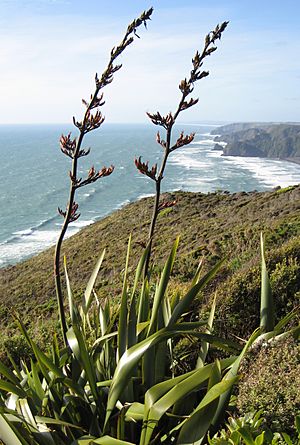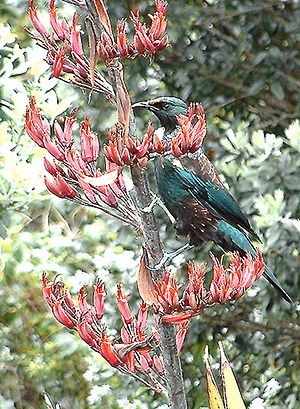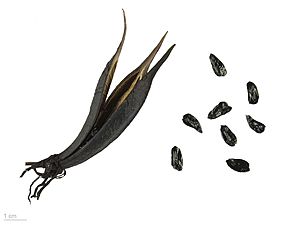New Zealand flax facts for kids
Quick facts for kids New Zealand flax |
|
|---|---|
 |
|
| Phormium tenax in bloom in Piha, west Auckland, New Zealand | |
| Scientific classification |
|
| Kingdom: | Plantae |
| Clade: | Tracheophytes |
| Clade: | Angiosperms |
| Clade: | Monocots |
| Order: | Asparagales |
| Family: | Asphodelaceae |
| Subfamily: | Hemerocallidoideae |
| Genus: | Phormium J.R. Forst. & G. Forst. |
| Type species | |
| Phormium tenax |
|
| Species | |
Phormium is a group of two plant species that belong to the family Asphodelaceae. One of these species grows only in New Zealand. The other grows naturally in New Zealand and on Norfolk Island.
These plants are often called flax in New Zealand. Outside New Zealand, they are known as New Zealand flax or flax lily. However, they are not related to the flax plant (Linum usitatissimum) found in the Northern Hemisphere. That type of flax has been used by people for a very long time, since 30,000 B.C.
Contents
Plant Classification
Scientists group plants into families based on how they are related. Phormium is now placed in the family Asphodelaceae. This family also includes daylilies (Hemerocallis). In the past, Phormium was part of a different family called Agavaceae.
There are two main species of Phormium: Phormium colensoi and Phormium tenax. There are also many different types of cultivated plants, called cultivars.
The name Phormium was first used by two German naturalists, Johann Reinhold Forster and his son Georg Forster, in 1775. They found these plants while on Captain James Cook's second expedition. They collected samples from Queen Charlotte Sound in New Zealand, and also from Norfolk Island.
The name Phormium comes from an Ancient Greek word meaning "basket." The word tenax is Latin and means "holding fast" or "strong." This refers to the plant's tough fibers.
Description and Life Cycle

Phormium is a plant that lives for many years. It has tough, sword-shaped leaves that can grow up to 3 meters (about 10 feet) long. They can also be up to 125 millimeters (about 5 inches) wide. The leaves are usually dark green. Some types have colored edges or central lines.
There are many cultivated types of Phormium. Their leaves can be light green, pink, or even a deep reddish-brown. Some have stripes of different colors like green, red, bronze, pink, and yellow.
Tall, stiff stalks grow up to 5 meters (about 16 feet) high from the plant. In November (in New Zealand), these stalks produce groups of curved, tube-like flowers. These flowers turn bright red when they are ready. They make a lot of nectar to attract birds like the tui and various insects. After the flowers are pollinated, seedpods grow. Each pod holds hundreds of tiny seeds. The wind then spreads these seeds far and wide.
Where Phormium Grows
Phormium tenax grows naturally in New Zealand and on Norfolk Island. P. colensoi is found only in New Zealand. Both species have been planted in many other parts of the world that have similar mild climates. People grow them for their fibers and as decorative garden plants.
These plants usually grow in swamps or low, wet areas. However, they can also grow well in many other types of environments.
Growing Phormium
The two Phormium species can easily breed with each other. This means they can create new types of plants. There are many different kinds of Phormium plants that people grow in gardens.
In 2005-2006, the Royal Horticultural Society listed 75 different types of Phormium plants. Some of these cultivated varieties have won awards. For example, the following types have received the Royal Horticultural Society's Award of Garden Merit for growing well in UK gardens:
- Phormium colensoi subsp. hookeri 'Cream Delight'
- Phormium colensoi subsp. hookeri 'Tricolor'
- Phormium 'Duet'
- Phormium 'Sundowner'
- Phormium tenax 'Variegatum'
- Phormium 'Yellow Wave'
Uses of Phormium
Phormium plants have long, strong fibers in their leaves. These fibers have been very important in the culture, history, and economy of New Zealand. People around the world also grow these plants for their fibers and as beautiful plants in gardens.
Related pages
- New Zealand hemp, known as New Zealand flax outside New Zealand, an evergreen perennial plant native to New Zealand and Norfolk Island.
See also
 In Spanish: Phormium para niños
In Spanish: Phormium para niños


